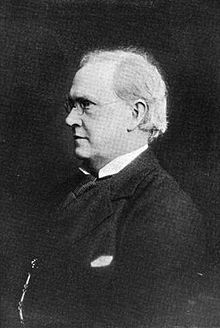Horace Lamb
Sir Horace Lamb (born November 29, 1849 in Stockport , England, † December 4, 1934 in Cambridge , England) was a British mathematician and physicist who mainly dealt with theoretical hydrodynamics (including acoustics).
Life
Lamb was the son of a foreman in a cotton mill who was known for his inventions. Since his father died early, he grew up with an aunt. At the age of 17 he won a scholarship in classical languages for Cambridge . In 1868 he began studying mathematics and physics at Trinity College , Cambridge, where he studied with George Gabriel Stokes and James Clerk Maxwell . In 1872 he was Second Wrangler in the Tripos and received the Smith Prize . He then became a Fellow at Trinity College and lecturer at the same time . In 1875 he became a professor of mathematics at the University of Adelaide in Australia. In 1885 he went back to England as a professor at the University of Manchester , where he stayed until his retirement in 1920. He then moved to Cambridge, where an honorary chair was established for him ( Rayleigh Lectureship ).
Lamb worked in the fields of electrodynamics, hydrodynamics and elasticity theory and their applications, where he was particularly interested in all kinds of oscillation phenomena, i.e. dynamics. For example, he explained mathematically the observations of John William Strutt, 3rd Baron Rayleigh, on the vibrations of thin plates and examined the vibrations of elastic spheres. He was known not least for his textbooks. In 1917 he described the Lamb waves named after him .
In 1884 Lamb was elected as a member (" Fellow ") in the Royal Society , which awarded him in 1902 with the Royal Medal and in 1923 with the Copley Medal . He was twice Vice President of the Royal Society. From 1902 to 1904 he was President of the London Mathematical Society , whose De Morgan Medal he received in 1911. He was a seven-time honorary doctor, a member of the Accademia dei Lincei and an Honorary Fellow of the Royal Society of Edinburgh . In 1931 he was ennobled.
Lamb had been married since 1875 and had seven children, including the painter Henry , the archaeologist Dorothy , the studied historian Helen and the studied historian Walter.
Works
- The mathematical theory of the motion of fluids , 1878
- Hydrodynamics. Cambridge University Press, 1895, 1999, ISBN 0-521-45868-4 (reprint of 1895 edition)
- Dynamical Theory of Sound (Dover Phoenix Editions). Dover Publications 2004, ISBN 0-486-43916-X (Reprint of New York 1910 edition)
- Infinitesimal Calculus , 1897
- Higher Mechanics , 1920
- Vibrations of elastic systems, especially acoustics , Encyclopedia Mathem.Wwissenschaften, Vol. 4, Part 4, 1906
literature
- RB Potts : Lamb, Sir Horace (1849-1934) in: Australian Dictionary of Biography Volume 5, Melbourne University Press, 1974, pp. 54-55
- R. Radok: A profile of Horace Lamb. University Press, Townsville 1980
Web links
- John J. O'Connor, Edmund F. Robertson : Horace Lamb. In: MacTutor History of Mathematics archive .
- Literature by and about Horace Lamb in the catalog of the German National Library
- Literature by Horace Lamb at the SBBPK
Individual evidence
- ↑ Sometimes November 27 is also given.
- ^ Fellows Directory. Biographical Index: Former RSE Fellows 1783–2002. (PDF file) Royal Society of Edinburgh, accessed December 29, 2019 .
| personal data | |
|---|---|
| SURNAME | Lamb, Horace |
| BRIEF DESCRIPTION | British mathematician and physicist |
| DATE OF BIRTH | November 29, 1849 |
| PLACE OF BIRTH | Stockport , England |
| DATE OF DEATH | 4th December 1934 |
| Place of death | Cambridge , England |
